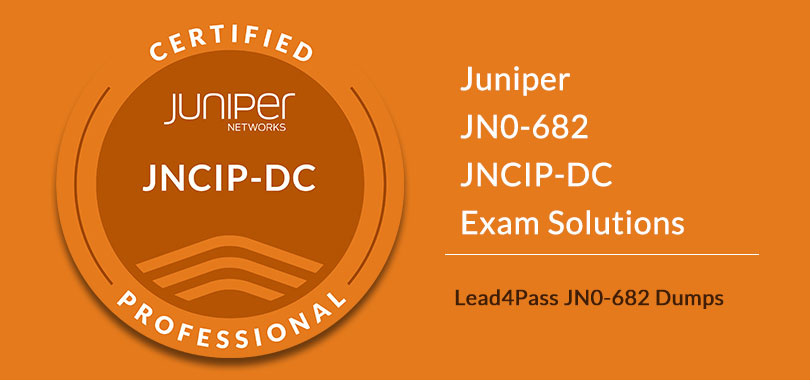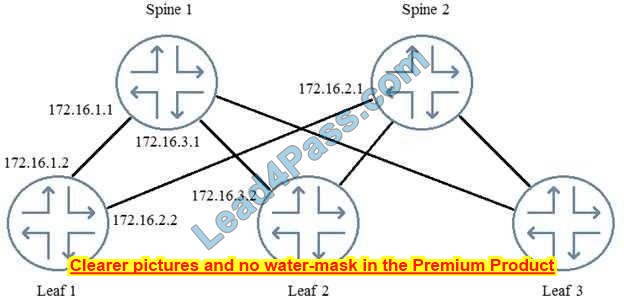Juniper JN0-682 JNCIP-DC Exam Solutions | Lead4Pass JN0-682 Dumps

leads4pass JN0-682 Dumps contains 130 latest exam questions and answers, covering more than 90% of Juniper JN0-682 “Data Center Professional (JNCIP-DC)” actual exam questions! For your best Exam Solutions.
leads4pass JN0-682 exam questions and answers are updated throughout the year! Guaranteed to be available anytime! Download JN0-682 Dumps: https://www.leads4pass.com/jn0-682.html
One-time use 365 days free update! You can also choose the learning method that suits you according to your learning habits: PDF and VCE learning formats are provided to help you learn easily and pass Juniper JN0-682 JNCIP-DC Exam successfully.
Here you can always get more: leads4pass JN0-682 dumps page provides download free Demo for you to experience, you can also participate in the following online practice tests
Latest Juniper JN0-682 dumps Exam Questions
| From | Number of exam questions | Associated certification |
| leads4pass | 15 | JNCIP-DC |
Question 1:
You work in a data center where VMs and hosts are frequently moved. Your design needs to eliminate inefficient traffic flows.
In this scenario, which two solutions will satisfy this requirement? (Choose two.)
A. VXLAN
B. EVPN
C. VMTO
D. VPLS
Correct Answer: BC
Question 2:
You are an engineer for a hosting company. You have a new customer that wants the ability to connect any VLAN on any port. They want to have all VLANs map to a single bridge domain and EVPN instance (EVI). They control all their own routing and just need the connectivity.
Which two parameters should you configure to achieve these goals? (Choose two.)
A. instance-type mac-vrf
B. service-type VLAN-aware
C. service-type VLAN-bundle
D. instance-type virtual-switch
Correct Answer: CD
Question 3:
You are troubleshooting a traditional Clos Layer 3 IP fabric in your data center. You are reviewing the BGP configuration for one of your spine devices.

Referring to the exhibit, which statement is correct?
A. This spine device will not install multiple next hops for remote destinations in its routing table.
B. This spine device will not install any routes for remote destinations in its routing table.
C. This spine device has three neighboring leaf devices.
D. This spine device has three neighboring spine devices.
Correct Answer: C
Question 4:
You are an architect for an enterprise organization that currently operates three data centers with plans to expand to five data centers in the next year. You already notice large amounts of BUM flooding and must control this issue before implementing the next two data centers.
Which feature would address this issue?
A. type-5 routes
B. type-6 routes
C. mesh groups
D. VXLAN BUM traffic filter
Correct Answer: B
Question 5:
You are building an IP fabric underlay for your data center. You are asked to ensure that the two spine devices are in the same AS (65000) while the six-leaf devices are in a different AS (65512). In this scenario, which two statements are correct by default? (Choose two.)
A. All BGP routes advertised by a leaf device will be accepted on the spine devices.
B. A leaf device will accept all BGP routes received from the spine that originated from another leaf device.
C. All BGP routes advertised by a leaf device will be rejected on the spine devices.
D. A leaf device will reject all BGP routes received from the spine that originated from another leaf device.
Correct Answer: AB
Question 6:
Which two statements are correct about a spine and leaf-based IP fabric? (Choose two.)
A. Traffic is diverted within the fabric when a device or link fails.
B. There is no need for redundancy at the server level.
C. Leaf switches broadcast frames to all other leaf devices.
D. Clos networks demonstrate good scaling features.
Correct Answer: AD
Question 7:
You are designing a Layer 3 fabric underlay using EBGP. You will implement an E VPN- signaled VXLAN overlay on the Layer 3 fabric.
In this scenario, what must you do in the underlay to ensure that the VXLAN overlay will be able to function properly?
A. The underlay should support the PIM protocol
B. Each device in the underlay should advertise its loopback address
C. The underlay should be configured with a separate VRF for each potential tenant
D. The underlay should advertise the host connected interlaces on all leaf device
Correct Answer: B
Question 8:
You are logged in to Leaf 1. When examining the routing table, you notice that you have no routes from Leaf 2.

Referring to the exhibit, which two commands would you use to troubleshoot the problem? (Choose two.)
A. From Leaf 2, issue the show route advertising-protocol bgp 172.16.1.2 command.
B. From Spine 1, issue the show route advertising-protocol bgp 172.16.1.1 command.
C. From Spine 1, issue the show route advertising-protocol bgp 172.16.1.2 command.
D. From Leaf 1, issue the show route receive-protocol bgp 172.16.1.1 command.
Correct Answer: CD
Question 9:
You are configuring VXLAN. and you must ensure that all switches for the multicast groups advertise their existence and learn about other VTEPs In this scenario. which protocol will accomplish this task?
A. OSPF
B. EVPN
C. PIM
D. BOP
Correct Answer: C
Question 10:
You are building a new IP fabric data center underlay network and want to ensure predicted load-balancing behavior for traffic, traversing the fabric. What are two approaches you should take to satisfy the requirement in this scenario? (Choose two.)
A. Ensure that all spine devices are in the same switched mode.
B. Ensure that all uplinks are 40GbE.
C. Ensure that every leaf node has an uplink spine node
D. Ensure that every node has a link to every other leaf node
Correct Answer: AC
Question 11:
What is the purpose of the command shown in the exhibit?

A. To stop the reception of transit multicast traffic when there are no interested receives attached to the local VTEP
B. To disable the group2390.0.1 across the entire VXLAN.
C. To stop the transmission of transit multicast traffic when there are no interested receives attached to a remote VTEP
D. To disallow IGMP request for group 239.0.01 from the host attached to the local VTEP
Correct Answer: C
Question 12:
You are required to create an IP fabric for your new data center. In this scenario, which protocol would be used to support EVPN?
A. IS-IS with correct TLVs enabled
B. MP-BGP
C. OSPF
D. any protocol with the appropriate APIs
Correct Answer: B
Question 13:
Which protocol is used between VCF member devices to create a loop-free topology?
A. LLDP
B. MDTP
C. RSTP
D. VCCP
Correct Answer: D
Question 14:
A customer wants to connect two data centers on different subnets using EVPN. What are the two implications of using different IP subnets at each site? (Choose two.)
A. Using different IP subnets at each site allows Layer 3 gateways to exchange only type-3 routes.
B. MAC addresses will need to be advertised between the data centers.
C. MAC addresses will not need to be advertised between the data centers.
D. Using different IP subnets at each site allows Layer 3 gateways to exchange only type-5 routes.
Correct Answer: CD
Question 15:
What are the three advantages of using MPLS for data center interconnects? (Choose two.)
A. Dedicated MPLS backbones for Layer 1 and Layer 3 DCIs
B. Any to any connectivity
C. Dedicated connections between customer sites
D. Sub 50 ms failover times
E. Traffic engineering
Correct Answer: ADE
…
leads4pass JN0-682 Dumps contains 130 latest exam questions and answers, one-time use enjoys free updates for 365 days! It also provides PDF and VCE multiple learning formats to assist you in easily learning and passing the Juniper JN0-682 JNCIP-DC Exam!
Use Juniper JN0-682 JNCIP-DC Exam Solutions: Download JN0-682 dumps with PDF and VCE: https://www.leads4pass.com/jn0-682.html, to help you pass the exam 100% successfully.